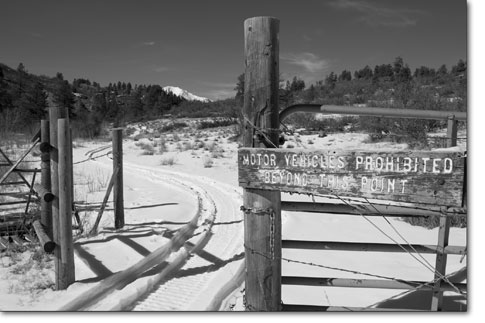| ||
| Habitat Stamp lands on Dry Fork New fee comes to one of area’s most popular trails SideStory: How to get stamped
by Will Sands A new fee has hit one of Durango’s most popular trails. Beginning this year, mountain bikers, hikers and horseback riders will be required to pay for use of the Dry Fork trailhead. Contrary to previous reports, users must carry a Colorado Division of Wildlife Habitat Stamp when accessing the Dry Fork Loop from the south side. Considered one of the area’s finest stretches of singletrack, the Dry Fork Loop is located northwest of Durango. The loop contains a small chunk of the Colorado Trail, is sited entirely on national forest land and is especially popular with the cycling community. Though the users can access Dry Fork from the Colorado Trail’s Junction Creek trailhead, most opt for the parking lot at the trail’s south side in the vicinity of Lightner Creek. This more popular trailhead now carries a price. Last May, Gov. Bill Owens signed legislation requiring all users of Colorado State Wildlife areas to buy a “Colorado Wildlife Habitat Stamp.” The stamp went into effect on Jan. 1 and costs $10 per year, or are included in the price of a hunting or fishing license. “If you’re going to be on a State Wildlife Area and are between the ages of 19 and 64, you’re going to need a habitat stamp, and if you fish or hunt, you’re going to be buying that stamp anyway,” explained Joe Lewandowski, public information specialist for the Colorado Division of Wildlife’s Southwest Region. In the case of the Dry Fork, a portion of the access road and the trail’s parking lot are within the Perins Peak SWA. Consequently, all users of the southern trailhead must now carry the stamp. “If people just drove or rode their bikes up the road and turned around, they wouldn’t need the stamp,” Lewandowski explained. “But anyone accessing the parking lot or the trail will need a wildlife stamp. The trailhead is basically right on the border. There’s no way to avoid being on the state wildlife area when you start your ride or hike.” The DOW has posted signs at all of the state wildlife areas explaining the habitat stamp, and Lewandowski argued that the stamp program has been well publicized and Colorado residents should know about it. In addition, education will be emphasized during the stamp’s first year, and warnings and explanations will be provided for first-time infractions. Those who blatantly disregard the rule will be ticketed for $68. Lewandowski also stressed that state wildlife areas are unlike public lands. The areas have been set aside as wildlife sanctuaries and were purchased with funds from hunting and fishing licenses. “Most people don’t understand that hunters and anglers have footed the bill for all wildlife management for a century,” he said. “But in the last 30 years, a lot of emphasis has been put on nongame and endangered species. The emphasis of the work is evolving and growing, but the source of revenue hasn’t changed.” The stamp program is expected to raise approximately $2.3 million per year and will help the DOW and the state’s wildlife as they adapt to these changing times. “Throughout the state, habitat is being squeezed by development,” Lewandowski said. “The stamp program is a long-term method for securing habitat. All the money must be used for habitat protection. The DOW cannot use this money to buy copiers or pick-up trucks.” With all of these factors in mind, Lewandowski argued that the agency needs to seek money from all users of its lands, not just hunters and fishermen. He said he hopes people taking advantage of the Dry Fork trailhead will not flinch at the prospect of spending $10 for the resource. “Look at it this way,” Lewandowski concluded. “For the price of a couple of frappuccino-skinny-tall-vente-mocha-pumpkin lattes, you can buy a no-calorie habitat stamp, and that money will go to a damn good cause.” The new fee is beginning to stir emotions among Dry Fork users. However, the local advocacy group, Trails 2000, has accepted the DOW’s view of the new fee and is encouraging users to cough up a few extra buck for wildlife. “It’s a new fee,” acknowledged Mary Monroe, Trails 2000 executive director. “Trails 2000 feels that wildlife is important to all of us, and we will be helping to get the word out.” •
|


